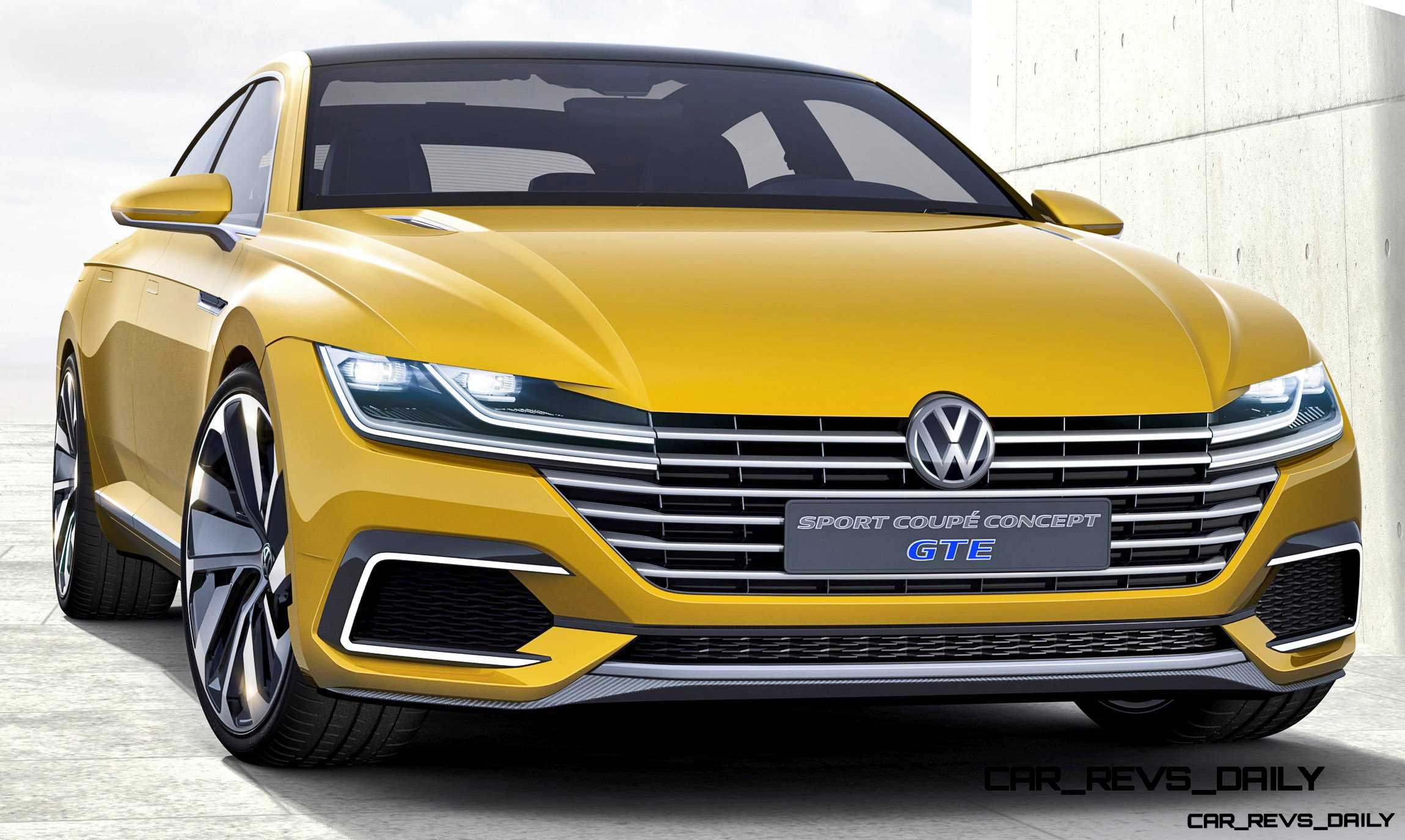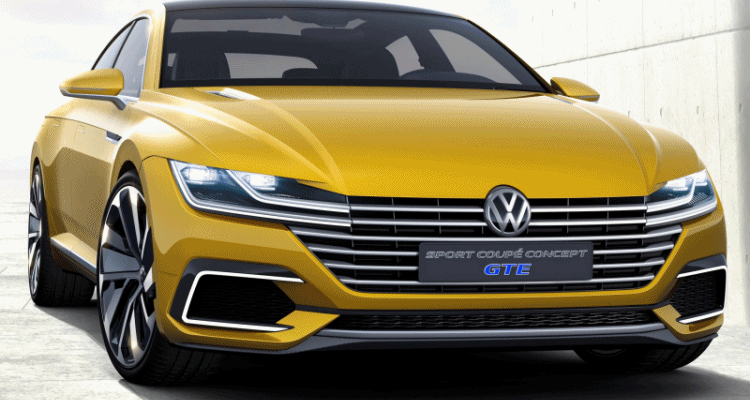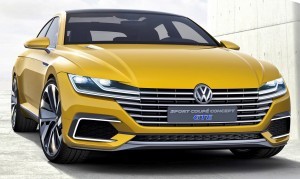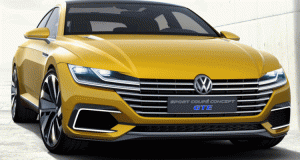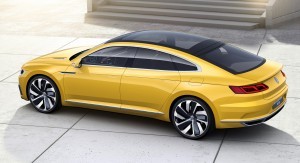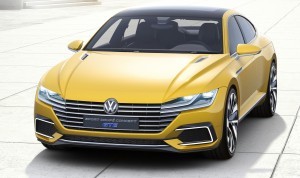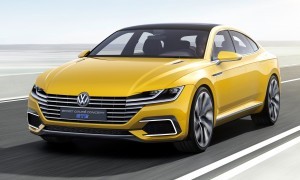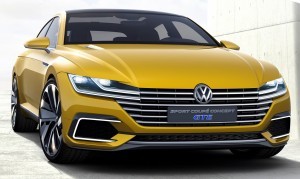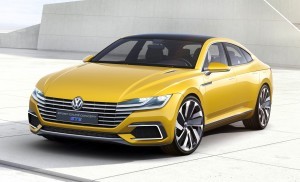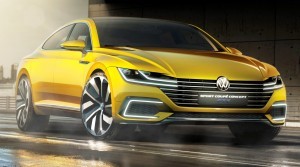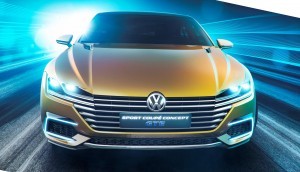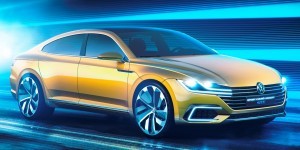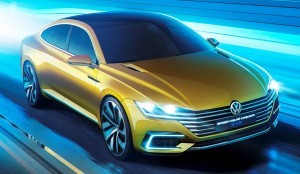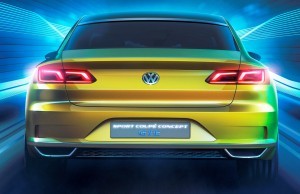VW’s Geneva Preview night is absolutely packed to the rafters with new cars, concepts and tech reveals. The big VW brand rollout is the new Sport Coupe Concept GTE — a mouthful of a name but an easily-digestible new design language.
The dramatic nose treatment is most obviously new, with a full-frame grille consisting of horizontal slats throughout. The chrome grille elements flow nicely into an LED extension of the grille shape. This new style is visible on the 2015 Touareg, but vastly more unique and strikingly on this concept.
Size and market potential-wise, the Sport Coupe Concept GTE is likely to show the way forward for the US-market Passat CC. This US-market model shares its platform and wide-body shape with the Euro-only Scirocco. Therefore, one might assume this shape previews not just the next Passat CC but also the next Scirocco.
VW has a long history of amazing concepts becoming dry, lifeless production models — but it is good to see some sign of fresh style ideas on a new VW.
2015 Volkswagen Sport Coupe Concept GTE
SPORT COUPÉ CONCEPT GTE MAKES WORLD DEBUT AT THE GENEVA AUTO SHOW
Mar 2, 2015
Four-door coupé marks beginning of a new design era at Volkswagen
Wolfsburg/Geneva, March 2015 —Volkswagen will debut the Sport Coupé Concept GTE at the 2015 Geneva International Motor Show, heralding a new and progressive Volkswagen design language. “Evolution and revolution come together in the Sport Coupé Concept GTE. This concept is based on Volkswagen design DNA, which has been visibly sharpened even more. It shows how the highest-volume brand of our Group is shaping the immediate future,” says Walter de Silva, Head of Design of Volkswagen AG.
Dr Heinz-Jakob Neusser, Volkswagen Brand Board Member for Development, elaborates: “This breathtakingly dynamic coupé is unlike any other to appear in this class. The design of the Sport Coupé Concept GTE is an impressive alternative to the classic sedans of the B and C segments—it has the style of a sport coupé that is enriched by the functionality of a large hatchback and the interior space of a sedan.” Klaus Bischoff, Head of Design of the Volkswagen Brand, adds: “The Sport Coupé Concept GTE is another milestone of expressive design. With this concept car, Volkswagen is not only showing a new model’s design, but also initial glimpses of a new design era.”
The interior of the Sport Coupé Concept GTE is as innovative as its exterior. It features extremely clean design, matchless ergonomics and new interactive interfaces between human and machine—including the use of the driver’s biometric data and a new Active Info Display that has a 3D appearance. The upshot is an avant-garde interior ambience that is in complete harmony with its expressive exterior design.
Under the skin, the car is also very innovative. The GTE designation promises a plug-in hybrid drive system and that’s what this concept delivers. Volkswagen’s regular GTE models can be driven approximately 32 miles in all-electric mode and yet they can cover very long distances with confidence. GTE versions are conceivable in all vehicle classes, as demonstrated with the Cross Coupe GTE SUV concept vehicle that was shown at the North American International Auto Show in Detroit.
The Sport Coupé Concept GTE adds a new facet to its GTE philosophy. The 374-horsepower (279 kW) GTE fastback delivers the long-distance properties of a Gran Turismo while simultaneously enabling zero-emission driving, thanks to its two electric motors and externally chargeable battery. The concept car has a top speed of 155 mph and has an impressive EC average combined fuel consumption of 118 mpg.
Volkswagen differentiates between the B, C and D segments in the mid-size and premium classes. The latest Passat, for example, is setting standards in the high-volume section of the B segment; the Volkswagen CC is positioned in the upper B segment; and the Phaeton, as a premium sedan, is in the D segment. The Sport Coupé Concept is breaking out of its current segment and into the C segment. Klaus Bischoff: “Internally, the Sport Coupé Concept GTE is a car that we position above today’s Volkswagen CC. We are enriching this segment with a premium design which is as exclusive as it is dynamic, and which casts the term avant-garde in a new light.”
Exterior design.
The concept car is underpinned again by Volkswagen’s modular transverse matrix (MQB), which allows for great packaging and proportions. The most important dimension for the design of a car is the ratio of the exterior length to the wheelbase. The concept car is 191.7 inches long with an incredibly long wheelbase of 118.9 inches, creating an interior that is 73.7 inches long, as well as short body overhangs: 35.8 inches at the front and 44.1 inches at the back. Its low height (55.4 inches), impressive width (73.4 inches) and large 21-inch wheels give the car a spectacular stance. Yet, because of the MQB packaging, the Sport Coupé Concept GTE also offers excellent front and rear headroom and a 17.0 cubic foot trunk.
Front end. The radiator grille, headlights and VW badge merge into a completely new interpretation of the Volkswagen front end. The designers specifically emphasized three-dimensionality. Towards its outer edges, the radiator grille borders the LED dual headlights that are framed by an aluminum radiator grille crosspiece, whose ends take an upward turn, like the winglets of a modern jet airplane. This shape is repeated on the exterior and in the interior, running as a common thread throughout the vehicle’s design.
The uppermost radiator grille crosspiece frames the inner LED modules (high beams and Daytime Running Lights); the second crosspiece wraps around the outer LED modules (low beams and DRLs). The winglets also function as DRLs thanks to integrated bands of LEDs and as turn signals by alternating the LED color at the top ends of the bands. The Sport Coupé Concept GTE‘s DRL signature is completed by the C-shaped LEDs arranged around the lower air intakes (an identifying characteristic of electric and plug-in hybrid models from Volkswagen).
Beneath the two upper radiator grille crosspieces, there are four additional bars. Each trim piece is narrower than the one above it, and together they form a wide “V” that is framed by body-colored area of the bumper.
Silhouette. The Sport Coupé Concept GTE is a coupé with four doors and a hatchback. This approach led to a design that emphasises long, extended lines, a low overall height and an athletic body form. The car’s silhouette is uncompromised: the roofline assumes the shape of a flattened curve extending from the A-pillar—set far back for a long hood—to the rear body. The extremely low-set C-pillar, which develops seamlessly from the roofline, dominates the back end of the car. Air vents in the front fenders and hood have chrome elements that mimic the stylistic theme of the winglets around the headlights.
The precision of the car’s design is illustrated by two elements of the car’s silhouette. First, the lower window line, which looks as though it were carved into the body, is continued as a sharp edge into the front fenders. Second, the character line that runs below the window sill is the most important line on the vehicle. At the rear, it is designed as what is known as an undercut. Here, the character line is drawn slightly outward to emphasize the strong shoulder section and generate a light-refracting edge. This undercut reduces gradually as it runs towards the front of the car, where the character line extends into the front wheelarch.
Rear section. The roofline, including the C-pillars, transitions directly into the vertical surface of the rear section, just like a classical sports car’s. The rear spoiler visually lengthens the car; laterally, the spoiler’s lower edge is continued above the taillights and directly into the character line. The roof section has a lot of tumblehome from front to rear, creating space for a muscular shoulder section, which in turn transitions into the powerfully flared wheelarches.
Like the headlights, the LED taillights are designed to have a 3D appearance, with a light signature that apes the winglets at the front. On each side of the vehicle, the basic lighting unit consists of two glossy black elements, in which the brake light, turn signal, and rear light LEDs have been integrated. At night, the black background surfaces are not visible, which makes the illuminated LED elements appear to hover, creating an unmistakable light signature.
Interior design
The new interfaces in the Sport Coupé Concept GTE are appealing to the eye as well as being a high-tech tour de force. The instrument cluster is a prototype of a newly conceptualised Active Info Display with 3D graphics. The display has a 12.3-inch diagonal and was designed in such a way that the virtual space blends into the real border of the instrument cluster, via a patented ambient light effect, thus creating a free-form surface. In its basic configuration, the digital display depicts two round instruments; a power meter on the left and a speedometer on the right with a field between them for all sorts of information. The new free-form surface makes the round instruments appear to hover in virtual space. The graphics of the displays change according to the driving mode (E-mode or GTE mode).
The central infotainment system’s touchscreen has a 10.1 inch diagonal; the area alongside this screen also features touch-sensitive slider controls for the HVAC. The rear seating area has a 12.3-inch touchscreen that serves as the media control module and is integrated between the individual seats. It can be used to operate functions that include the media library, telephone and navigation. Rear passengers can also control the two 10.1-inch screens embedded in the backrests of the front seats via this media control unit. In addition, the slider controls integrated alongside the 12.3-inch display can be used to operate the automatic climate control system, for a four-zone system.
For the first time, Volkswagen is interfacing the car’s electronics directly with the driver. Based on the driver’s biometric data, the Sport Coupé Concept GTE determines, via a smartwatch or armband for measuring the driver’s vital functions, whether to select a route that includes an exciting country road or a gentle route instead.
Monitoring of biometric data begins as soon as the driver inputs the destination by voice or on the touchscreen—but only if the driver wants the data stored in the device to be used as input for the navigation system. Time and distance are secondary factors here. In this navigation mode, which is individually tailored to the driver, the sole purpose is to experience maximum driving enjoyment.
The navigation system recommends routes that are displayed in lists or via Cover Flow; in this case, apps such as Instagram are used to show additional information and images of the individual routes. The driver can view the selected route in the infotainment system before heading out. Simultaneously, the driver gets detailed information on the type of route and on the traffic, weather and road conditions along the route.
To get the most precise real-time information, the system evaluates car-to-car data from other vehicles that are already driving the same route ahead of the Sport Coupé Concept GTE. At the same time, the system compares route conditions to the vehicle’s status, such as remaining battery charge.
Ambience. One unique feature inside the car is the way the line from the dash panel and door shoulders appears to wrap around the four passengers like a cocoon. The dash panel, designed with horizontal elements and leather-trimmed at the top, uniformly transitions into the front door trim panels and then into the rear doors. The dash panel itself is designed to be straightforward, clean and minimalistic. In the upper area, three slender and elegant aluminum slots function as vents, with a slender piano-black accent and another aluminum vent beneath them that spans the entire width of the dash panel.
The center console rises towards the dash panel where it meets the infotainment system, just like a sports car. Here too, elegant gloss-black and thin aluminum surrounds are dominant styling elements. Forming a contrast to this, beneath the “hovering” design of the console, there’s a layer that looks like natural wood. The same material is found on the door panels and on the steering wheel. Among the practical details are cupholders that can warm or cool the drinks placed in them. The 6-speed DSG has shift-by-wire logic and stays in a central position, like a joystick. The R, N and D selections are activated by a flick of the wrist, while P is set by pushing a separate button that is integrated in the shift lever.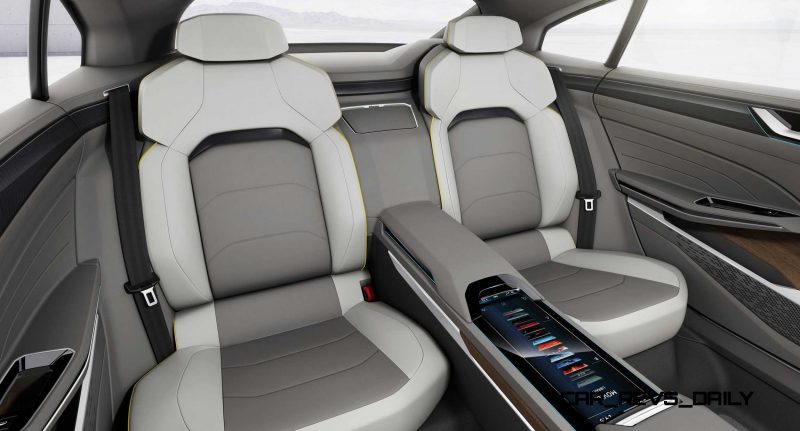
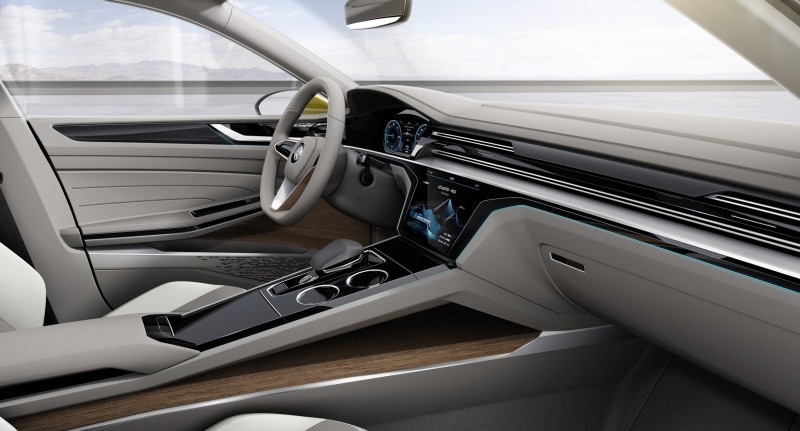
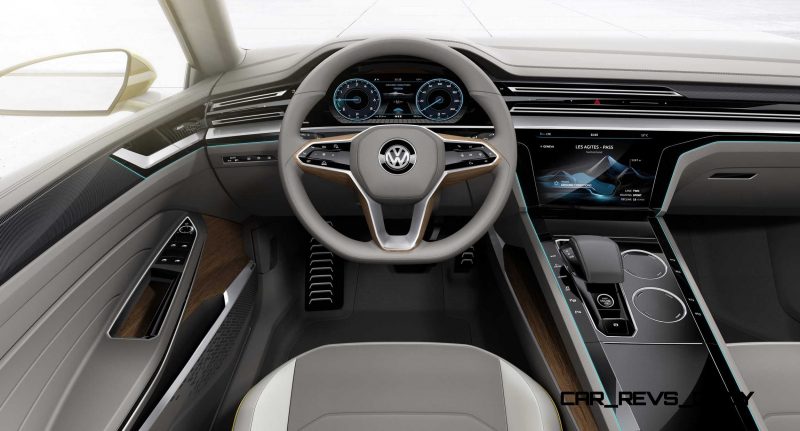
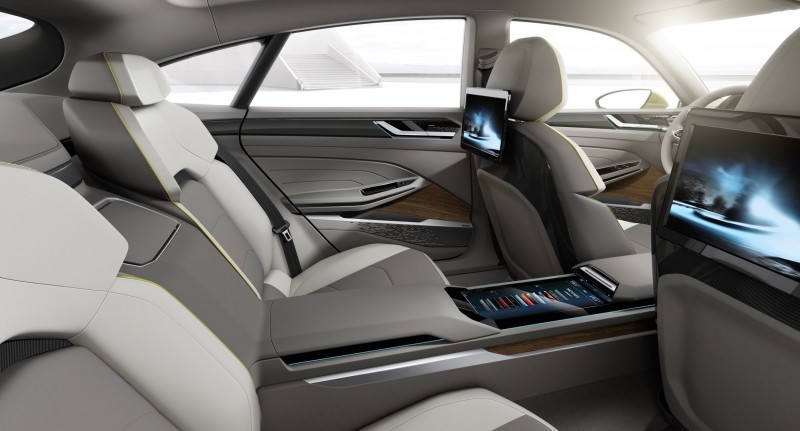
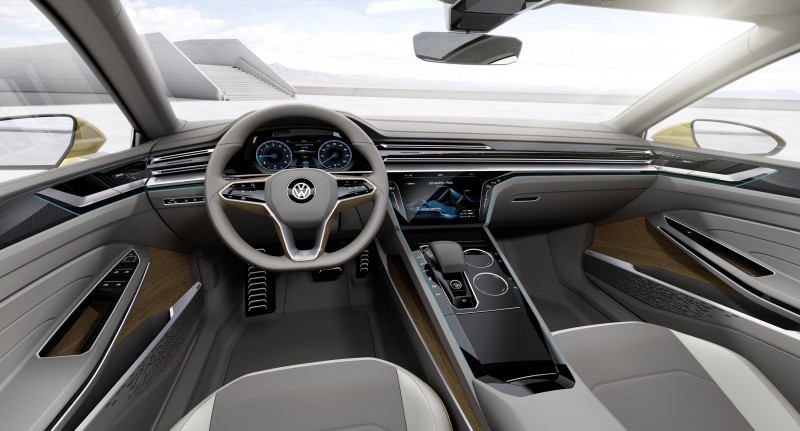
Drive system
The Sport Coupé Concept GTE is powered by a plug-in hybrid drive system that is both economical and sporty. The concept car uses a turbocharged 3.0-litre TSI V6 direct-injection engine that produces 295 horsepower (220 kW) and maximum torque of 369 pound feet. The electrical components consist of a lithium-ion battery that’s housed in the center tunnel and two electric motors. The 54-hp (40 kW0 front motor is integrated in the 6-speed DSG dual-clutch automatic transmission and the rear electric motor develops 114 hp (85 kW). The total available system power is 374 hp (279 kW).
If necessary, the system’s power can be distributed to all four wheels thanks to the rear electric motor and an “electric driveshaft”. In the sporty GTE mode, the 155 mph coupé accelerates from zero to 62 mph in just 5.0 seconds. Despite this dynamic performance, the concept car has an EC combined fuel consumption of 118 mpg. In addition, the Sport Coupé Concept GTE can be driven all-electrically, with zero emissions, for a distance of at least 32 miles. The total driving range on one tank of gasoline is more than 745 miles.
Hybrid. The concept car starts in Hybrid Mode by default. The Sport Coupé Concept GTE is then a classical full hybrid that charges the battery via regenerative braking and automatically uses the V6 engine and/or the electric motor depending on the drive situation. In this mode, the battery state of charge is kept constant; the driver can actively influence this by using the battery hold function.
- Coasting: As soon as the driver takes his or her foot off the accelerator and the battery is sufficiently charged, the gasoline engine and electric motors are shut down and disengaged from the drivetrain.
- Recuperation Mode: If the driver removes his or her foot from the accelerator or brakes when the battery is not sufficiently charged, both electric motors work as generators and feed the energy generated during braking to the lithium-ion battery. In this case, too, the V6 engine is shut down and disengaged.
- Driving with the V6 engine: When the gasoline engine alone is powering the vehicle, the concept car is purely front-wheel drive to achieve excellent fuel economy.
“E-Mode”. In E-mode, which the driver activates by button push, only the 114-hp electric motor at the rear axle provides propulsive power. In all-electric driving, the V6 TSI is decoupled from the drivetrain by disengaging the clutch, and it is shut off. As soon as the six-cylinder engine needs to be used again—due to the battery’s charge state or other parameters—it is coupled to the drivetrain again within fractions of a second without any jolts. The lithium-ion battery, which has a capacity of 10.7 kWh, is responsible for supplying energy to the electric motors.
GTE. The driver uses the GTE button to switch to the most dynamic side of the vehicle. This makes the throttle, transmission and steering characteristics even sportier. In addition, the V6 engine and the electric motors work together to deliver the full system output and the maximum system torque.
Battery Charge/Battery Hold. The dual-mode Battery Hold (energy content of the battery stays constant) and Battery Charge (battery is charged whilst driving) is activated via a sub-menu in the infotainment system. It serves to hold the vehicle in E-Mode, for example, when the driver knows they are about to enter an urban area.
“Electric driveshaft” all-wheel-drive system. All four wheels are powered as soon as the system detects it is needed. In this case (and when the battery charge is low), the front electric motor is employed exclusively as a generator that is driven by the gasoline engine in order to provide the power for its counterpart at the rear axle. As the power to drive the rear axle flows electronically, the all-wheel-drive system is referred to as an “electric driveshaft”. Since the V6 engine drives the rear electric motor via the front motor, all-wheel drive is available even when the battery has a low state of charge and the car is running as a plug-in-hybrid.
Technical data
| Body / wheels | |
| Concept | 4-door and 4-seat coupé |
| Length / width / height | 191.7 in / 73.4 in / 55.4 in |
| Wheelbase | 118.9 in |
| Cargo capacity | 17.0 cu ft |
| Wheels / tires | 9.5 J x 21-in, ET45 / 265/30 R21 |
| Drive | |
| Drive system | Plug-in hybrid |
| Drivetrain | All-wheel drive with “electric driveshaft” |
| Petrol engine | 3.0 V6 TSI (turbocharged, direct-injection) 220 kW / 295 hp / 369 lb-ft |
| Electric motors, front and rear | 54 hp/ 162 lb-ft and 114 hp / 199 lb-ft |
| System power | 279 kW / 374 hp |
| Gearbox | 6-speed DSG (DQ400E) |
| Battery type | Lithium-ion |
| Battery energy capacity | 10.7 kWh |
| Performance / fuel economy data | |
| Top speed, hybrid | 155 mph |
| 0-62 mph | 5.0 s |
| Fuel consumption (NEDC, combined) | 118 mpg |
| CO2 emissions (NEDC, combined) | 46 g/km |
| Range, electric | > 32 miles |
| Range, total | > 745 miles |
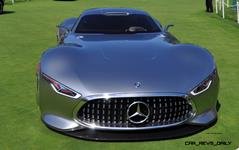
Tom Burkart is the founder and managing editor of Car-Revs-Daily.com, an innovative and rapidly-expanding automotive news magazine.
He holds a Journalism JBA degree from the University of Wisconsin – Madison. Tom currently resides in Charleston, South Carolina with his two amazing dogs, Drake and Tank.
Mr. Burkart is available for all questions and concerns by email Tom(at)car-revs-daily.com.

